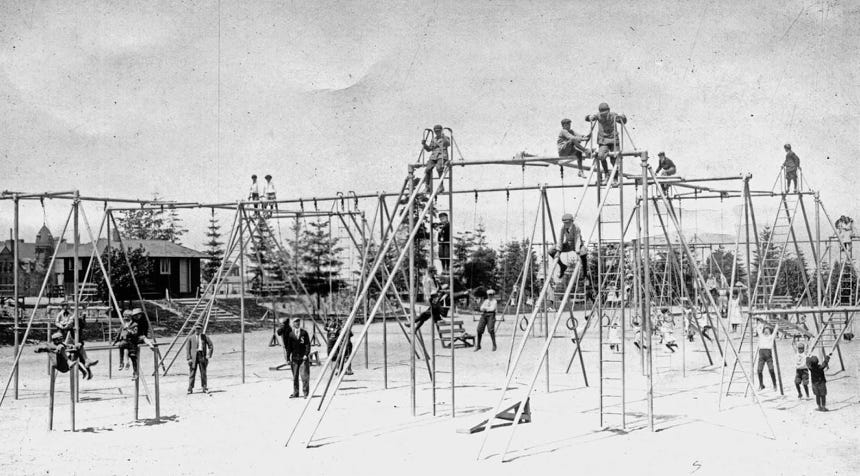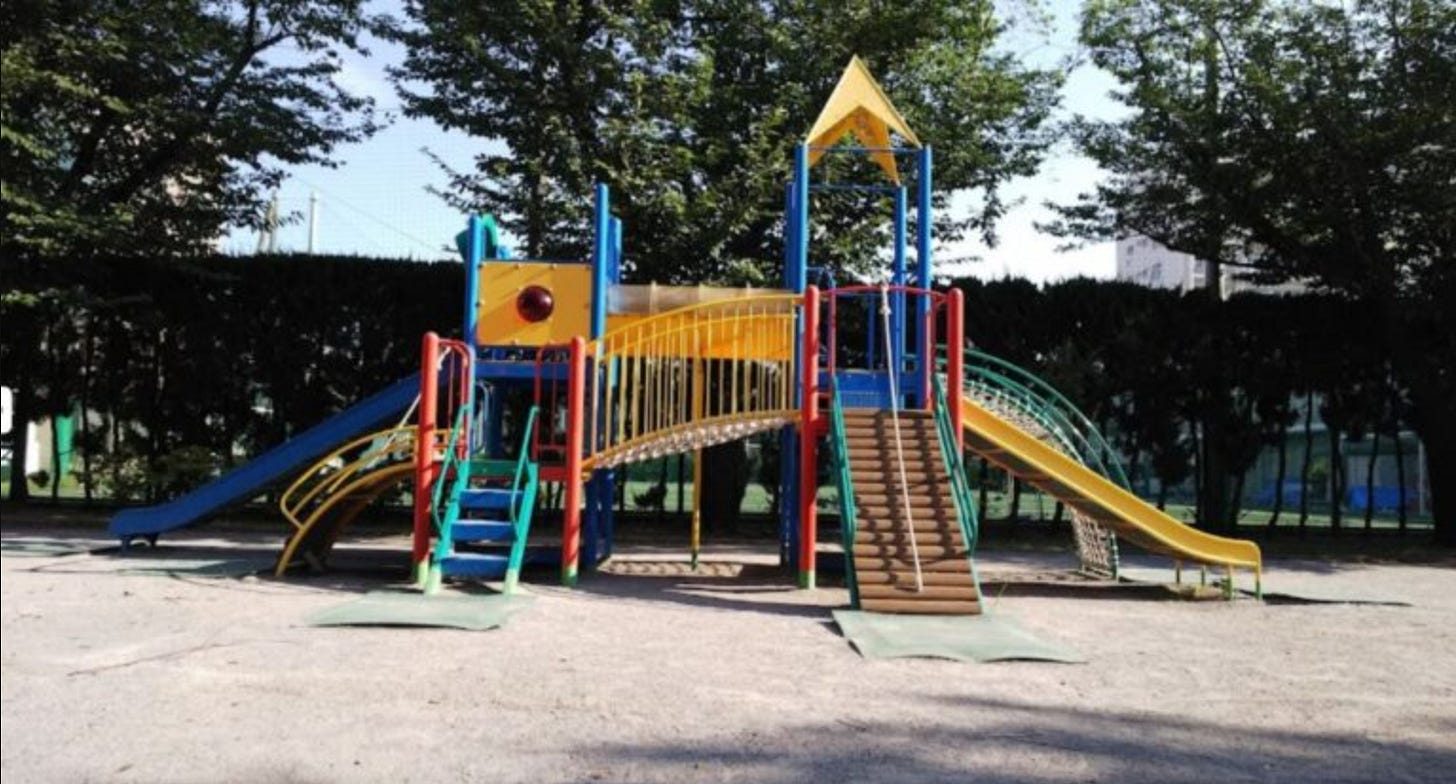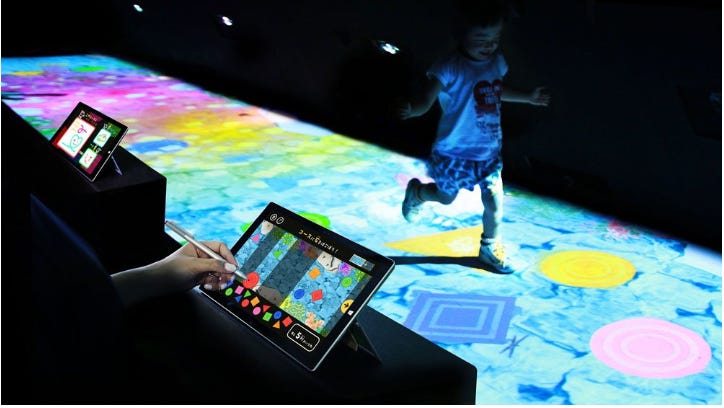Evolution of the Playscapes
The Evolution of Playscapes within Western European Culture.
A playscape is a ‘landscape of play’ in other words, an environment designed to promote, enhance or protect the act of playing for a range of users. These can include highly designed spaces like football pitches or gyms or natural environments such as climbing a tree. Humans have been defining these spaces and improving them since the dawn of civilisation and I want to explore the recent history of these spaces.
Throughout the history of playscapes, there has been a clear evolution in the design of spaces for children to play in. The article is to run through this history so we can understand the evolution and how these developments are related to the changes in research on childhood learning and play which continues to grow.
Each type of playground design has positives and negatives and through an analytical approach to reviewing designs, I will highlight the positives and negatives of the playgrounds and try to give a history that can help inform further designs of playscapes.
Ancient Playscapes
The idea of designated spaces for play can be traced back to ancient civilizations. Ancient societies recognized the importance of play for children's development and incorporated play areas into their communities.
In ancient Greece, physical fitness and education were highly valued, and play was an essential part of a child's upbringing. One notable playground-like space was the palaestra, an open-air courtyard within gymnasiums. Here, children engaged in various physical activities, including running, jumping, wrestling, and ball games. These activities not only promote physical development but also fostered social interaction and competitiveness among the youth.
One of the earliest recorded instances of playgrounds can be found in the imperial palaces of ancient China, which had a long-standing tradition of play and recreation, such as the Forbidden City in Beijing. These sprawling palace complexes often featured meticulously designed gardens with ponds, bridges, and pavilions where members of the royal family and their children could engage in leisure activities and play games. The gardens provided a serene and beautiful environment for children to explore, stimulating their imagination and creativity.
In ancient Egypt, children had access to various play areas both indoors and outdoors. Depictions in ancient Egyptian art and literature reveal scenes of children playing with toys, participating in organized games, and engaging in imaginative play. Outdoor spaces like temple courtyards, public squares, and riverbanks served as playgrounds where children could run, climb, and engage in physical activities. Additionally, ancient Egyptian households often had dedicated rooms or spaces for play, filled with toys, board games, and figurines.
These examples from ancient Greece, China, and Egypt demonstrate that playgrounds or play-like spaces have been an integral part of human culture since ancient times. These early civilizations recognized the importance of play in children's development, providing them with opportunities for physical, social, and imaginative experiences.
By studying the ancient history of playgrounds, we can gain valuable insights into the enduring significance of play and its impact on children's growth across different cultures and time periods. The evolution of playscapes throughout history reflects humanity's evolving understanding of childhood development and the changing societal attitudes towards play. The understanding of these core benefits and ancient cultural habits from all corners of history needs to be recorded as technology is increasingly designed to distract and encourage children away from these traditional playscapes and into digital alternatives which don’t provide the core benefits.
Late 18th / Early 19th Century: Early Playscape Design
In the 19th century, the living conditions were extremely poor due to the boom of the industrial era during Victorian times this allowed for the creation of high-density housing in close proximity to factories which often had little to no attention towards the play of children, the term teenager was yet to be coined and Children were often focused on chores of the household.
It wasn’t until 1840 when schools became a legal obligation for children and they stopped working that there was an emphasis put on the development of the child. However, this was only availed to wealthy families and wasn’t until 1870 The Education Act was passed and schools were made available to all children between the ages between five and thirteen. (Gamble 2006)The importance of children’s play was been highlighted and the movement towards the building of these spaces was beginning. Certain church groups such as The Salvation Army, The Band of Hope and the Shining Light would organize play activities during the evening and holidays however children that attended would always be asked to learn some religious text. (Hendricks 2001)
The playgrounds and often playgrounds within schools during the 19th century were been built with the aim of solving the problems of lower-class children by socialising them with higher-social-class children and adults. These playgrounds were starting to feature in the construction of parks throughout England and were built for both the child and adults. Queens Park in Manchester was built in 1849, which included circular swings, a ball and shuttle-cock ground, skipping rope and swing grounds, another shuttle-cock ground, a quoit alley, a skittle alley, an archery ground, and a cricket ground. These activities were not only aimed at children but towards adults as well this shows how the emphasis of playground design was on the improvement of the social aspects of children and how through play grounds could develop children especially lower class children in teaching them ‘social morality’.(Hendricks 2001)
After this point, the construction of playgrounds became common throughout the 19th century, not only in the UK but around the world. These parks often used the same materials and equipment. As Canadian Thomas Burton wrote in 1976 “There is a certain uniformity and repetition about leisure opportunities available”. He was speaking about the clone stamping of the play equipment which was viewed as not dangerous. Such elements as the Swing, Steel Climbers, Seesaw, Sandpit and the allowance for large open spaces where children could play as groups. (Hendricks 2001) The stamp of the playground ‘off the shelve’ elements still finds its way into the design of playscapes today, This is not to say that these elements do not offer important aspects to the development of a child however they are not directly related to the site they are put in and do not utilize the full potential that can be offered to the play of a child.(Gamble 2001)The design of playgrounds throughout the 19th century and early 20th century have shown their emphasis on social improvements and the development of the quality of life for working children. This emphasis led to a lack of concern for the variety of types of play, the physical development of a child and their exposure to nature experiences. (Willis, 2009)
Wartime Playspaces.
The large destruction of a lot of infrastructure throughout Europe in dense urban areas lead to the discovery of a new type of playground. This new type of playspaces discovered by children was called ‘junk playgrounds’. These spaces were often created in vacant lots and allowed children to use spare construction materials to build, destroy and create their own playscapes.(Hendricks 2001) The benefits of these playscapes addressed the development of the children, which had not been directly addressed in previous traditional playgrounds.
The concept of these playscapes had been voiced by Danish architect Carl Theodor Sorensen whose main goal was to transform the status of the park from an object of aesthetic contemplation into a site of active and participatory recreation. He wanted to create an enclosed space with unwanted objects and materials would be left and allow the children to creatively use these materials to create a playscape of their own. (Stine 1997)
This was first tried out in Emdrup in Copenhagen in 1943 during the German occupation. These playscapes provided a base where children could take risks, experiment with fire, build, fail and destroy, as a way of knowing the world empirically, through doing. An important aspect to the success of these sites was the role of the play leader/supervisor. Bertlesen, Emdrup’s first play leader said that
‘the initiative must come from the children themselves... I cannot, and indeed will not, teach the children anything.’
This idea that children must learn for themselves through the action of doing is an extremely important factor and allows children to develop a wide range of life skills. (Hendricks 2001)An English Landscape Architect, Lady Allen of hurtwood, visited Emdrup just after the end of world war 1 and returned to England and presented these junk playgrounds as a solution to the wartime problem of Juvenile delinquency. She used the bombed sites created by the Blitz. She described the creation of these junk playgrounds as a way of playfully curing the physical and psychological damage of the war. The first two playgrounds were opened in London in 1948 and 1949, one on the site of a bombed church in Cumberwell, and the other on a bombed dwelling in Paddington. These sites were in general closed and returned to the legal owner of the property in due course however, this style of the playground was renamed Adventure Playgrounds to suit the British palette, however, most of these playgrounds are different to the original junk playground due to what is viewed as ‘safe’ by policymakers and parents as safe materials for the children to be using. This has translated into modern times with playscapes constructed with ever more worry about the risk and who is liable for it. These adventure playgrounds enable play elements to be built out of the natural environment and waste materials found by children have almost completely disappeared and been replaced with pre-manufactured internationally shipped play equipment that has been designed in a controlled manner to create a less dangerous environment. (Andrews and O’Connor 1980)
This evolution of the adventure playground has not been all positive because, during the process of making the playgrounds less dangerous, it has removed the ‘positive risk development and healthy lifestyle choices’(Staempfli (2009) pg 268-269). This teaches the children lessons which can be important life skills. These playgrounds gave the children an opportunity to work together and cooperatively solve problems as well as let them explore their physical capabilities when constructing their own playscapes, these are aspects of play which the traditional style does not offer. (Staempfli 2009)
Late 20th Century: Progression of Playscape Design
The translation of playscapes to the 20th century was moulded by higher safety standards in America. This process allowed for a formation of a new style of playscape design which was designed to directly focus on the innovative thinking and social development which adventure playgrounds had started to explore. (Willis 2009)
These modern playscapes have taken advantage of technological advancements and the availability of various materials. The use of hard plastics and composite materials has allowed for the creation of vibrant, durable, and visually appealing play equipment. One example of this is the use of colourful plastic slides and swings that can be found in many playgrounds. These materials offer flexibility in design and can be moulded into different shapes and forms, providing a wide range of play experiences for children.
Furthermore, with the advent of globalized manufacturing, the mass production of specialized play equipment has become more accessible. This has led to the rapid spread of traditional playscape equipment, such as jungle gyms, seesaws, and merry-go-rounds, in playgrounds worldwide. These standardized play structures provide familiar experiences for children regardless of their geographic location.
In addition to traditional equipment, innovative and interactive play features have emerged in modern playground design. For instance, climbing walls, rope courses, and sensory play elements have gained popularity, offering children new challenges and opportunities for physical and cognitive development. These dynamic and engaging play structures encourage exploration, problem-solving, and social interaction among children.
Overall, the translation of playscapes into the 20th century has witnessed the utilization of advanced materials, mass production techniques, and technological innovations. These developments have enriched the diversity and possibilities of modern playground design, providing children with engaging and stimulating environments for play and social development.
Towards the end of the 20th century, the design focus was shifting again. The use of local culture, geography, and history was being used to create playgrounds which were connected to the place they were in situ. (Playgrounds in Parks 2010)
The relationship between the children and their natural environment was been focused on. The concept of integrating nature with the teaching of children in their education is a concept which has been around throughout history as early as the 17th century when philosopher John Amos Comenius (1592–1670) said that
“A school garden should be connected with every school, where children can have the opportunity for leisurely gazing upon trees, flowers and herbs, and are taught to appreciate them”.
However northern European countries such as Sweden, Norway, Denmark, Germany and Holland, which have a very caring and considerate attitude towards the living conditions of children, have been focused on this trend more so than other countries. (Anja Novak et al. 2002)
The creations of these natural playgrounds are still intuitive to experiential Educators however there are a growing amount of studies that are showing the positive effects, that naturalistic factors have on the Child’s development.
The design of a natural playground consists of natural materials such as rocks, logs, hills, soil, sand, water, and big trees. These elements do not have to be processed or changed in any great deal the raw materials sometimes function as the best materials because it allows the children to utilise their imagination to the maximum. (Dyment and Bell 2008)
These natural playgrounds have allowed for the formation of forest schools. These schools integrate access to woodland play into the daily curriculum for students. Studies carried out on forest schools in Surrey, UK show that woodland learning can ‘increase self-esteem and confidence, improve motivation and encourage concentration…[and] improve physical motor skills”.[O’Brien 2009].
I will explore the role of nature within education further in other writings.
The Future of Playscapes
A good point to end on is the question of what does the future hold for playscapes?
By looking at how the playground has evolved, and understanding the forces behind why it has evolved this way, it allows for a greater understanding of the different typologies of play equipment and the functions behind them and how they might develop into the future.
Moreover, the rapid integration of technology has also influenced modern playscape design. From kids staying indoors playing video games to playgrounds now incorporate interactive elements like electronic games, augmented reality, and motion sensors, creating immersive play experiences for children. These technologically enhanced play environments aim to capture children's attention and promote both physical activity and cognitive engagement but the results are still to be seen.
Modern children are spending a high percentage of their free time with technology and large corporations are fighting for their attention with an increased amount of effort.
We need to build playscapes that fight just as hard for their attention, enjoyment and ability to educate. We need to explore where these playscapes can be created, whether inside the schoolyard, the street or the parks and playgrounds. These spaces can offer an opportunity to children that technology can not and as technology becomes cheaper and better at keeping their attention, our playscapes need to adapt.
The schoolyard is a perfect location to create a playscape within to teach a child key life skills which cannot be learnt in a classroom.
The opportunities that are presented in the playscape can promote the child’s environmental consciousness, improve the child’s cognitive, social and physical development and cannot be wasted. It is through the connection of traditional, imagination, contemporary and natural playscapes that we can provide a playscape that allows for the maximum development of the child.
Please leave a comment or share the article! I write these articles so I can hopefully experience the joy of nerdy conversations that I don’t get to have on a typical day! Hope you enjoyed reading it as much as I enjoyed writing it.
References :
Anja Novak, Debbie Wilken, Liane Lefaivre, Ingeborg de Roode Aldo Van Eyck, Desiging for children, Stedelijk Museum, Amsterdam 2002
Ginsburg, Golda S. and Kingery, J.N. “Evidence-based practice for childhood anxiety disorders.” (2007)
Youell, Biddy. “the importance of play and playfulness” European Journal of Psychotherapy and Counselling. (2008) Volume 10
Fjortoft, Ingunn and Sageie, Jostein. “the natural environment as a playground for children: Landscape description and analysis of a natural playscape.” Landscape and Urban Planning (2000) volume 48
Bartlett, Sheridan. “Children’s experience of the physical environment in poor urban settlements and the implications for policy, planning and practice.” Environment and Urbanization” (1999)
Nabhan, Gary Paul and Trimble, Stephen. The Geography of Childhood: Why Children Need Wild Places. Beacon Press: Boston MA. (1994)
Bartlett, Sheridan. “Children’s experience of the physical environment in poor urban settlements and the implications for policy, planning and practice.” Environment and Urbanization” (1999)
Fjotoft Ingunn, Sageie Jostein. The natural environment as a playground for children Landscape description and analyses of a natural playscape. Department of teacher education/department of computer science and Mathematics, telemark college, 3679 Notodden, Norway. (January 2000)
Anthea Holme and peter massie Children’s Play ‘A study of needs and opportunities’. Michael joseph live issues 1972
Andrew, Sean and O’Connor, Ciaran. Space for play. Comhchairdeas 1997
Sindiswa Mambinja 2008. School grounds as a place for environmental learning in the life skills learning programme. Master of Education at Rhodes University.
Thomspon, Angela M et al. Factors influencing the physically active leisure of children and youth: A Qualitative Study Leisure Sciences (2005). Vol 27
Gamble, James C, Evolution of the park: why the playground is the heart. Land Design Colaborative, Inc.
2006. Elevation: Park and Recreation Design Issue. American Society of Landscape Architecture http://www.landdesigncollaborative.com/new/newsArticle2.htm
Barbara E. Hendricks. Designing for play. 2001 Ashgate publishing ltd
Willis Ray, Childs Play History posted March 2009 available at http://www.thegypsypoet.co.uk/childs_play_history_2.html, accessed on 6th January 2013
Stine Sharon, Landscapes for Learning. Creating, Outdoor environments for children and youth. 1997 john wiley and sons inc.
‘New York city department of Parks and Recreation. Playgrounds in Parks’ 2010 http://www.nycgovoarks.org/sub_about/parks_history/playgrounds.html
Steampfli, Marianne B. ‘Reintroducing adventure into children’s outdoor play environments.’ Environment and behaviour. 2009 vol 41 no 2
Dyment J.E. and Bell, A.C. Grounds for movement: green school grounds as sites for promoting physical activity. Health education research 2008 volume 23 no 6
Joe Frost (2012) Evolution of American Playgrounds. Scholarpedia, 7(12):30423. Available at http://www.scholarpedia.org/article/Evolution_of_American_Playgrounds
The Institute of International and European Affairs, Climate Adaptation Framework, accessed on the 8th of January http://www.iiea.com/blogosphere/climate-adaptation-framework-published
Royal Society for the Prevention of Accidents, Safe Play At All Times SPLAAT): building site safety, 2003






